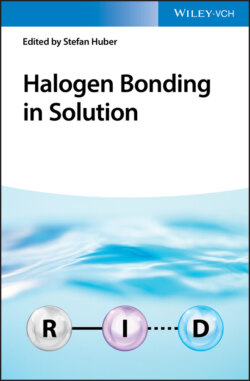Читать книгу Halogen Bonding in Solution - Группа авторов - Страница 23
1.3.3 Metal Complexes and Charge‐assisted Halogen Bonding Systems
ОглавлениеSo far, this chapter has described the use of neutral organic and neutral inorganic halogen bonding systems. The introduction of a formal positive charge results in a powerful electron‐withdrawing group that can enhance halogen bond donor strength and can be achieved by protonation or alkylation of various heteroatoms (e.g. nitrogen, phosphorus). Similarly, coordinating a transition metal center has also been used to activate halocarbon halogen bond donors. The methods are highlighted in Figure 1.10 where halopyridine is used as an example. Methylation (or alkylation) of nitrogen heterocycles has been frequently employed, resulting in a diverse set of pyridinium, imidazolium, and triazolium donors that have been studied. An early example of activating a halogen donor by pyridine methylation comes from Resnati and coworkers who evaluated N‐methyl‐3,5‐dibromopyridinium iodide (Figure 1.10, middle). The resulting crystal structure is highlighted by a helical structure formed between the cations and iodide [84]. The pyridinium, imidazolium, and triazolium systems noted earlier are frequently the subject of solution phase studies where solid‐state evaluations offer complementary information. As such, the interested reader is referred to their discussions in later chapters.
Figure 1.10 Methods to enhance the potency of a halogen bond donor. The ChemDraw figures provide a general description, while the ball‐and‐stick figures provide specific examples. Dotted lines indicate halogen or hydrogen bond contacts. CCDC ref codes: ALAJAY (top), BEYQIG (middle), RANSUV01 (bottom).
The combination of halogen bonds and transition metal complexes has been evaluated by several groups [85-89]. Early work from Brammer involved the protonation of pyridine halides, resulting in simultaneous charge‐assisted halogen and hydrogen bonding to perhalometallate ions (Figure 1.10, top) [90]. This would eventually lead to the construction of a classification system for crystal structures of halopyridinium⋯tetrahedral halometallate anion structures highlighting the tunability of the system from both the halogen bond donor and the halometallate acceptor [91]. The Brammer group also evaluated the activation of halogen bond donors through metal coordination, with an early study evaluating a family of compounds of the form trans‐[MCl2(NC5H4X‐3)2] (M = Pt, Pd; X = I, Br, Cl, F) (Figure 1.10, bottom) [92]. Within this system, all structures exhibited M–Cl⋯X–C interactions, except complexes of fluoropyridine. Through their collective works, they have demonstrated that stronger halogen bonds are expected to occur with lighter metal halides. While no structures were reported, the Brammer lab has also produced halogen bonding studies of metal fluorides [93] and metal hydrides [94] in solution. The evaluation of nickel fluorides as halogen and hydrogen bond acceptors showed that the enthalpies of the interactions are similar (indole as the hydrogen bond donor, compared with iodopentafluorobenzene as the halogen bond donor). Studies of secondary sphere halogen bond interactions have been extended to other metal ligands such as the cyano ligand where the nitrogen lone pair of electrons acts as the halogen bond acceptor. A systematic study of halopyridinium−hexacyanometallate complexes highlighted that a decrease in X⋯N distances correlated with increasing metal d‐electron count (Cr > Fe > Co) [95]. This was rationalized by greater π‐back bonding to the cyano ligand. Halogen bonding to the secondary sphere of metal complexes has also been reported with the oxo‐oxygens of the uranyl dication [96,97].
The influence of halogen bonding on magnetic and conductive solids with redox properties has also been recently investigated. Halogen bonding tetrathiafulvalene (TTF) derivatives (molecular conductors) permit the variation of charge while maintaining the isostructural nature of halogen bonding units and have been the subject of several investigations by Fourmigué and coworkers [98,99]. One example highlights a series of three isostructural complexes that vary the degree of charge transfer (neutral to ionic) between the TTF and tetracyanoquinodimethane derivatives, thereby directly showing the influence of charge on halogen bond strength [25]. The halogen bond has also played a role in the construction of nitroxide materials [100-102] and has been explored alongside ferromagnetic coordination polymers [103].
Figure 1.11 Representative examples of N‐iodoimide halogen bond donors (a). Scheme of halogen bond cocrystal/salt concept transfer (b).
((b) Modified from Makhotkina et al. [105].)
